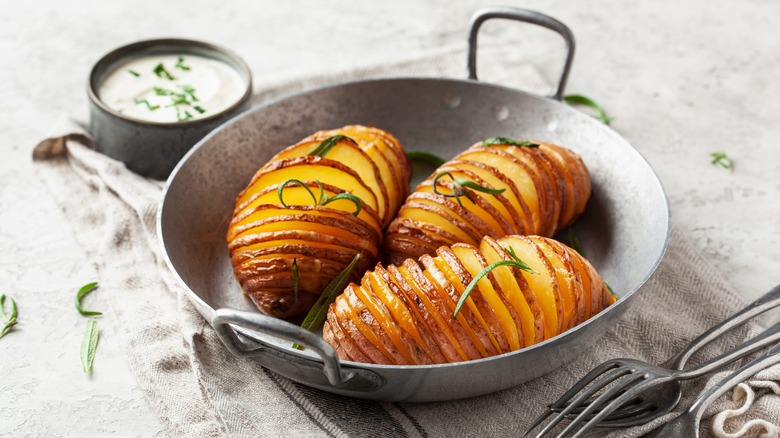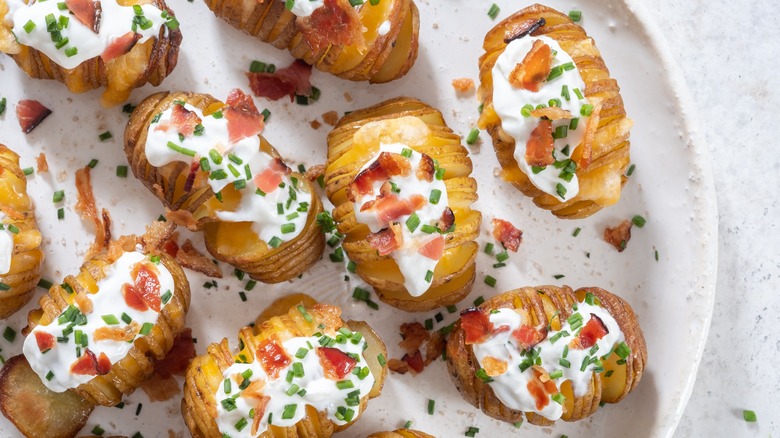Effortlessly Hasselback Potatoes With Ree Drummond's Genius Spoon Trick
With their appealing accordion-like appearance and crispy-yet-tender texture, hasselback potatoes are a special side dish that really demonstrates how much effort you've put into a fancy dinner. However, effort can quickly transform into hassle (no pun intended). It can be extremely finicky to make slices deep enough to let the potatoes fan out, without accidentally cutting through the entire tuber and ruining the presentation.
Luckily, Food Network's Ree Drummond has a simple tip to help you out: She puts wooden spoons on either side of the spuds to act as guides. Specifically, the handles of the spoons do the job. The utensils form a barrier between the knife and the cutting board, so when your knife hits the handles, you know to stop slicing and move on to the next cut. Each slice will be perfectly even and just deep enough, without the risk of chopping your taters in two.
Drummond uses the technique for hasselback sweet potatoes, but it works just as well for white or red spuds, such as in cheesy, garlicky giant hasselback potatoes. And you can use this trick on other appropriately-sized vegetables to make hasselback eggplants, zucchini, and even beets.
More ways to use spoons and make hasselbacking a breeze
Ree Drummond's spoon trick is already a huge headache-saver, but there's a way to make it even more efficient. If you find that the potato rolls around a little as you slice, due to its rounded underside, cut a thin slice off the bottom of the spud before you start. This will give it a more stable base, and make the potato less likely to slip.
When employing Drummond's method, it's important to use wooden spoons rather than metal, since hard surfaces can dull sharp knives. But if you don't have two wooden spoons, you can hasselback potatoes using chopsticks or wooden spatulas instead. Just make sure whatever utensil you use isn't thicker than a quarter of an inch, so that you can slice deep enough for the potato to fan out properly as it cooks.
If you're working with small spuds like fingerlings or baby potatoes, you can use a wooden spoon in a different way to help with slicing — another handy tip recommended by the Pioneer Woman. Instead of placing the spud between the handles, rest it in the curved head of the spoon and slice. This way, you only need one spoon, which can be great if you've already dirtied tons of utensils preparing for your dinner party.
Use the cuts to add extra flavor to hasselback potatoes
Once you've sliced hasselback potatoes, you'll want to pack in as much flavor as you can — and the cuts themselves present the perfect opportunity to do so. Basting the tubers with oil or butter, salt, and pepper as they cook is a basic step to make them crisp, but tucking seasonings and other ingredients between the layers is a must-try.
Cheese pairs perfectly with hasselbacks, as it does with all other potato preparations. Simply add sliced, shredded, or cubed cheese between each slice towards the end of the cooking time. Use a good melting cheese such as cheddar, mozzarella, Taleggio, or smoked gouda for the most temptingly gooey results. Minced garlic and herbs such as thyme or rosemary can really make the spuds sing. Alternatively, try spooning condiments between the potato layers once they've been cooked. Dress them with anything from chipotle sour cream to a garlicky classic homemade aioli.
As mentioned before, Ree Drummond's trick works great for other veggies. Try spooning rich tomato sauce and savory Parmesan cheese into eggplant cut hasselback-style for a tasty twist on a layered eggplant parmigiana recipe. Or, hasselback a selection of root vegetables and glaze them with miso paste, maple syrup, and chili flakes as they roast in the oven. This makes for an umami-rich showstopper of a side dish.



